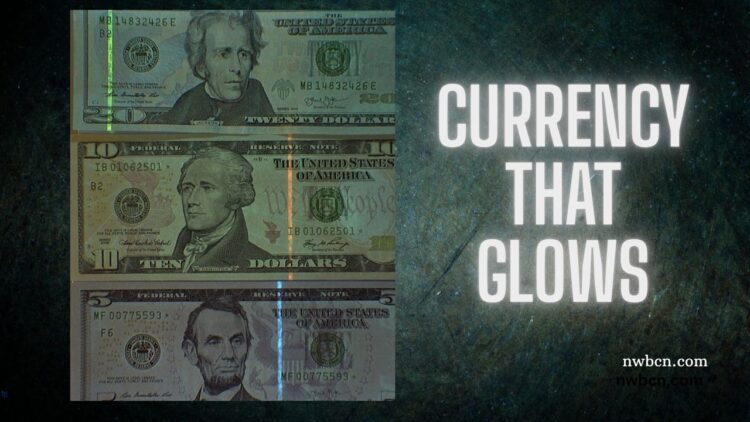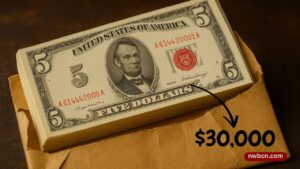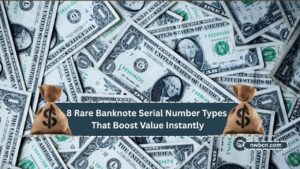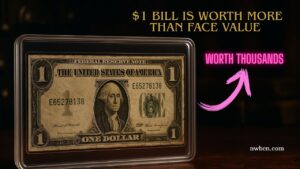Imagine holding a 1990s U.S. Federal Reserve Note under a UV (ultraviolet) lamp and watching it glow. This isn’t a trick of the light — it’s a built-in security feature. Federal Reserve Notes printed since the early 1990s include hidden UV-reactive threads that fluoresce in different colors under blacklight.
But why was this done? Which bills glow? And what does it mean for collectors and counterfeiters?
Let’s dive into the details of this fascinating security measure that brought a new glow to American currency.
Why UV Features Were Introduced
Combating Counterfeit Currency
By the late 1980s, counterfeiters were taking advantage of photocopiers and early digital printing to bleach low-denomination bills and reprint them as higher-value notes. This led to a rising concern among financial institutions and the government.
To counter this threat, the U.S. Bureau of Engraving and Printing (BEP) launched a new series of notes in 1990. This series introduced embedded polyester threads in denominations $5 and above, each glowing in a specific color under UV light, depending on the denomination.
Public Verification Made Easy
These glowing threads offered a quick way for retailers and banks to verify authenticity. They didn’t require special lab equipment—just a blacklight. This made on-the-spot detection far easier and more effective than previous tools.
The Science Behind UV-Reactive Currency
Embedded Security Thread
Each qualifying note contains a microprinted polyester thread, woven into the cotton-linen paper blend. It is not printed on the surface, but rather embedded during the production process, making removal or replication very difficult.
This thread is imprinted with text such as “USA TEN” or “USA TWENTY,” depending on the denomination. The positioning of the thread is also unique to each denomination.
Fluorescent Response
The thread contains fluorescent compounds that emit distinct colors under ultraviolet light. These reactions are highly visible in dark environments and are difficult to fake.
UV Colors by Denomination
Each denomination has a unique glow that acts like a color-coded fingerprint:
| Denomination | Series Introduced | UV Thread Color |
|---|---|---|
| $5 | 1994 | Blue |
| $10 | Early 1990s | Red/Orange |
| $20 | 1990 | Green |
| $50 | 1990 | Yellow |
| $100 | 1990 | Pink |
These color assignments provide quick authentication when viewed under a UV light. The threads are located in different positions on each denomination to add another layer of security.
Timeline: When UV Security Features Began
- 1990: Introduction of UV security thread in $100 and $50 notes
- Early 1990s: Expansion to $20 and $10 bills
- 1994: Implementation in $5 bills
- $1 and $2 notes were not included in these upgrades due to their lower risk of counterfeiting.
The security features were part of a larger redesign effort that included microprinting, watermarks, and color-shifting ink throughout the 1990s and early 2000s.
Additional Security Features in 1990s Currency
While the UV thread is impressive, it was only one of several new elements introduced to make notes more secure:
- Watermarks: Visible when held up to the light, these matched the portrait on the bill.
- Color-Shifting Ink: Found in the numeral of the denomination in the lower-right corner of some notes.
- Microprinting: Extremely small text placed around the portrait and other strategic areas.
- Paper Composition: Currency paper absorbs UV light, so the only glow comes from the embedded thread, ensuring contrast and clarity under blacklight.
Real-World Impact of UV Security Features
Counterfeiting Deterrent
The effectiveness of the UV thread was immediately apparent. One infamous case involved a teenager in the early 2000s who managed to replicate the look and feel of notes using custom paper. However, his fakes lacked the UV glow, making them easily identifiable to trained cash handlers.
Laboratory Validation
Experts use spectrofluorometers to analyze the emission intensity of these threads, allowing for detailed study of worn or counterfeit bills. Even after decades in circulation, authentic notes typically maintain their fluorescence.
Useful for Retail and Banking
Today, UV scanners are still used in thousands of retail and banking institutions across the U.S. A quick pass under a UV light provides an instant verification of the note’s authenticity.
How Collectors Use UV Light
Currency collectors often use UV light not just to verify authenticity, but also to check for errors, misprints, or unique variants in thread placement or color strength. A note that glows unexpectedly or incorrectly might indicate a rare printing error—making it potentially valuable.
Some collectors also seek out “transition notes”—those printed during the switch from older designs to newer ones. These can sometimes exhibit partial features from both series, including faded or offset UV threads.
Is UV Thread Still Relevant in Modern Notes?
Yes. Even with modern enhancements such as:
- 3D security ribbons
- Colorized backgrounds
- Micro-optic technology
… the UV thread remains a vital first-line defense. It’s inexpensive to verify, extremely difficult to replicate accurately, and effective in high-volume cash environments.
New designs may eventually transition toward polymer substrates and RFID technology, but the UV feature still provides essential, visible assurance today.
The use of UV-reactive security threads in 1990s Federal Reserve Notes was a turning point in the fight against counterfeiting. By introducing denomination-specific glowing threads, the U.S. Treasury gave consumers, banks, and law enforcement a fast, reliable tool to spot fake currency.
Even decades later, these glowing strips remain relevant, whether for retail verification or collector interest. They show how a simple beam of ultraviolet light can reveal the invisible story of how America protects its money.
Frequently Asked Questions
Q1: Do $1 and $2 bills glow under UV light?
No. The UV-reactive security threads were only added to denominations $5 and higher, starting in the early 1990s. $1 and $2 bills do not contain embedded UV threads.
Q2: Can counterfeiters fake the glowing thread?
It’s extremely difficult. The thread is embedded into the paper, not printed on the surface. Most counterfeiters fail to replicate the correct color, location, and microprinting of the authentic thread.
Q3: Does the glow fade over time?
While general wear and tear may cause a slight reduction in brightness, authentic UV threads usually remain visible under UV light even after years of circulation.




